Case Study: Change Management Challenges and Success at Vodafone Egypt
VerifiedAdded on 2023/06/11
|19
|4781
|88
Case Study
AI Summary
This case study examines Vodafone Egypt's implementation of change management procedures, focusing on the internal and external forces that prompted these changes. It begins by introducing change management concepts and Kotter's 8-step model, then provides a background of Vodafone Egypt, highlighting challenges such as the gap in skilled graduates and competition from other companies. The analysis delves into internal forces like the slow progress of Click GSM and external forces related to cultural structures within the company. It identifies key issues affecting the success of change management, particularly the 'buy-in' factor and leadership responsibility. The study also explores the types of changes implemented by CEO Ian Grey, including cultural management and strategic approaches, recommending the adoption of Kotter's 8-step model to create a conducive environment for change. The document concludes by emphasizing the importance of new visions and employee engagement in driving successful transitions within Vodafone Egypt. Desklib provides access to this and other solved assignments for students.
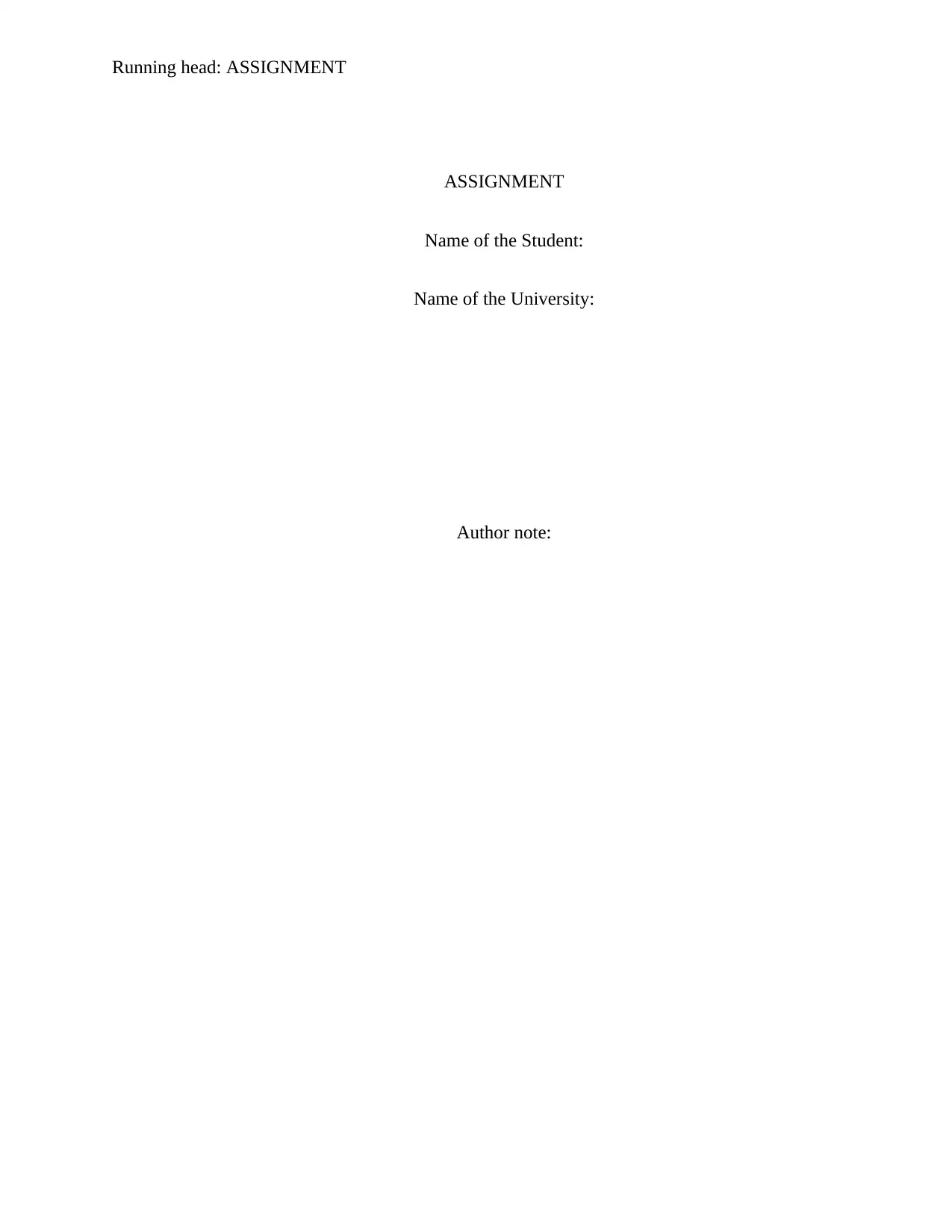
Running head: ASSIGNMENT
ASSIGNMENT
Name of the Student:
Name of the University:
Author note:
ASSIGNMENT
Name of the Student:
Name of the University:
Author note:
Paraphrase This Document
Need a fresh take? Get an instant paraphrase of this document with our AI Paraphraser
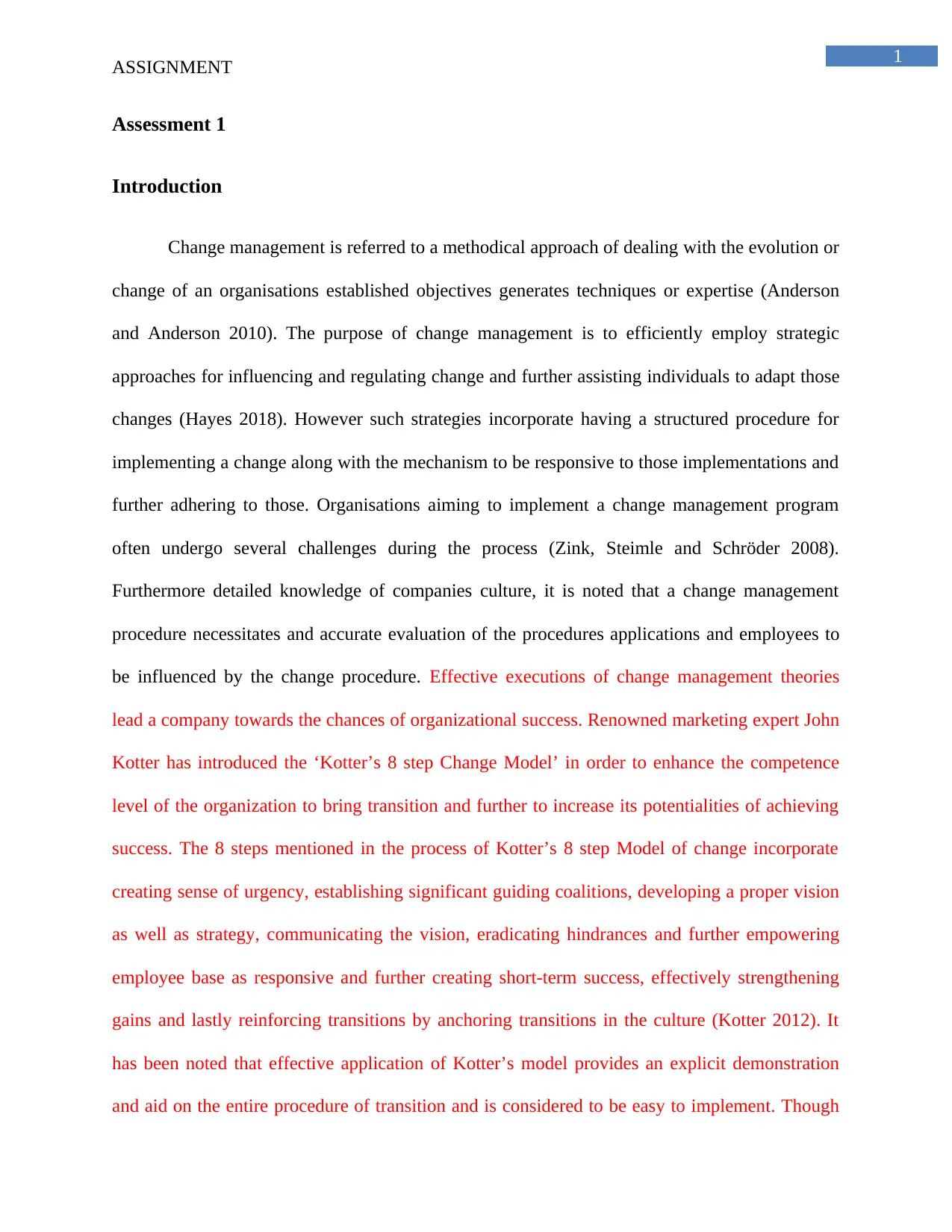
1
ASSIGNMENT
Assessment 1
Introduction
Change management is referred to a methodical approach of dealing with the evolution or
change of an organisations established objectives generates techniques or expertise (Anderson
and Anderson 2010). The purpose of change management is to efficiently employ strategic
approaches for influencing and regulating change and further assisting individuals to adapt those
changes (Hayes 2018). However such strategies incorporate having a structured procedure for
implementing a change along with the mechanism to be responsive to those implementations and
further adhering to those. Organisations aiming to implement a change management program
often undergo several challenges during the process (Zink, Steimle and Schröder 2008).
Furthermore detailed knowledge of companies culture, it is noted that a change management
procedure necessitates and accurate evaluation of the procedures applications and employees to
be influenced by the change procedure. Effective executions of change management theories
lead a company towards the chances of organizational success. Renowned marketing expert John
Kotter has introduced the ‘Kotter’s 8 step Change Model’ in order to enhance the competence
level of the organization to bring transition and further to increase its potentialities of achieving
success. The 8 steps mentioned in the process of Kotter’s 8 step Model of change incorporate
creating sense of urgency, establishing significant guiding coalitions, developing a proper vision
as well as strategy, communicating the vision, eradicating hindrances and further empowering
employee base as responsive and further creating short-term success, effectively strengthening
gains and lastly reinforcing transitions by anchoring transitions in the culture (Kotter 2012). It
has been noted that effective application of Kotter’s model provides an explicit demonstration
and aid on the entire procedure of transition and is considered to be easy to implement. Though
ASSIGNMENT
Assessment 1
Introduction
Change management is referred to a methodical approach of dealing with the evolution or
change of an organisations established objectives generates techniques or expertise (Anderson
and Anderson 2010). The purpose of change management is to efficiently employ strategic
approaches for influencing and regulating change and further assisting individuals to adapt those
changes (Hayes 2018). However such strategies incorporate having a structured procedure for
implementing a change along with the mechanism to be responsive to those implementations and
further adhering to those. Organisations aiming to implement a change management program
often undergo several challenges during the process (Zink, Steimle and Schröder 2008).
Furthermore detailed knowledge of companies culture, it is noted that a change management
procedure necessitates and accurate evaluation of the procedures applications and employees to
be influenced by the change procedure. Effective executions of change management theories
lead a company towards the chances of organizational success. Renowned marketing expert John
Kotter has introduced the ‘Kotter’s 8 step Change Model’ in order to enhance the competence
level of the organization to bring transition and further to increase its potentialities of achieving
success. The 8 steps mentioned in the process of Kotter’s 8 step Model of change incorporate
creating sense of urgency, establishing significant guiding coalitions, developing a proper vision
as well as strategy, communicating the vision, eradicating hindrances and further empowering
employee base as responsive and further creating short-term success, effectively strengthening
gains and lastly reinforcing transitions by anchoring transitions in the culture (Kotter 2012). It
has been noted that effective application of Kotter’s model provides an explicit demonstration
and aid on the entire procedure of transition and is considered to be easy to implement. Though
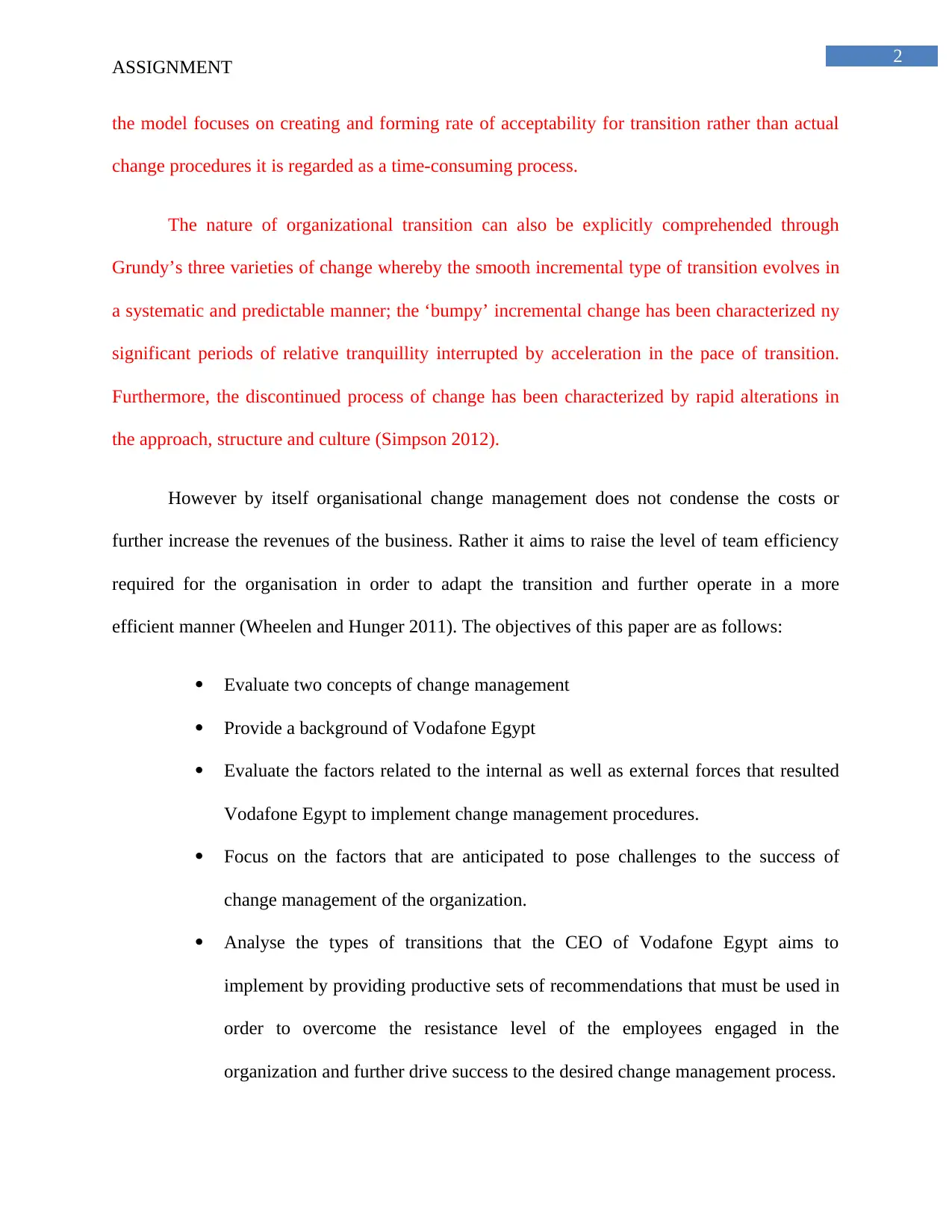
2
ASSIGNMENT
the model focuses on creating and forming rate of acceptability for transition rather than actual
change procedures it is regarded as a time-consuming process.
The nature of organizational transition can also be explicitly comprehended through
Grundy’s three varieties of change whereby the smooth incremental type of transition evolves in
a systematic and predictable manner; the ‘bumpy’ incremental change has been characterized ny
significant periods of relative tranquillity interrupted by acceleration in the pace of transition.
Furthermore, the discontinued process of change has been characterized by rapid alterations in
the approach, structure and culture (Simpson 2012).
However by itself organisational change management does not condense the costs or
further increase the revenues of the business. Rather it aims to raise the level of team efficiency
required for the organisation in order to adapt the transition and further operate in a more
efficient manner (Wheelen and Hunger 2011). The objectives of this paper are as follows:
Evaluate two concepts of change management
Provide a background of Vodafone Egypt
Evaluate the factors related to the internal as well as external forces that resulted
Vodafone Egypt to implement change management procedures.
Focus on the factors that are anticipated to pose challenges to the success of
change management of the organization.
Analyse the types of transitions that the CEO of Vodafone Egypt aims to
implement by providing productive sets of recommendations that must be used in
order to overcome the resistance level of the employees engaged in the
organization and further drive success to the desired change management process.
ASSIGNMENT
the model focuses on creating and forming rate of acceptability for transition rather than actual
change procedures it is regarded as a time-consuming process.
The nature of organizational transition can also be explicitly comprehended through
Grundy’s three varieties of change whereby the smooth incremental type of transition evolves in
a systematic and predictable manner; the ‘bumpy’ incremental change has been characterized ny
significant periods of relative tranquillity interrupted by acceleration in the pace of transition.
Furthermore, the discontinued process of change has been characterized by rapid alterations in
the approach, structure and culture (Simpson 2012).
However by itself organisational change management does not condense the costs or
further increase the revenues of the business. Rather it aims to raise the level of team efficiency
required for the organisation in order to adapt the transition and further operate in a more
efficient manner (Wheelen and Hunger 2011). The objectives of this paper are as follows:
Evaluate two concepts of change management
Provide a background of Vodafone Egypt
Evaluate the factors related to the internal as well as external forces that resulted
Vodafone Egypt to implement change management procedures.
Focus on the factors that are anticipated to pose challenges to the success of
change management of the organization.
Analyse the types of transitions that the CEO of Vodafone Egypt aims to
implement by providing productive sets of recommendations that must be used in
order to overcome the resistance level of the employees engaged in the
organization and further drive success to the desired change management process.
⊘ This is a preview!⊘
Do you want full access?
Subscribe today to unlock all pages.

Trusted by 1+ million students worldwide

3
ASSIGNMENT
Background
Vodafone has gained image recognition since last few years as the largest mobile network
operator in the world operating over 70 Nations within its corporate domain. Reports reveal that
over 90% of the company’s shares with an approximate value of around 200 billion US dollars
have been located outside its home nation of the United Kingdom (Harlow 2016). However it has
been noted that the business Enterprise has formulated an effective strategy to provide mobile
network services to both Global and domestic customer base catering the affluent as well as
financially emerging nations globally at competitive rates further ensuring suitable and accurate
technological services along with consumer driven products. The primary aim of Vodafone lies
on achieving utmost success and attaining the recognition of being one of the leading mobile
network providers with the increasing competition in the Global market. However in this
intensively competitive market domain the organization has been experiencing great degree of
competitiveness from its rivals such as Mannesmann (Harlow 2016). However it has been noted
that Vodafone had successfully overpowered the competition proposed by its rival and has
transformed itself into one of the dominated mobile operating service provider in the European
region. It is further to note that the major proportion of revenues of the organization is generated
from airtime revenues and has reportedly established associations with significant network
equipment providers as well as Nokia, Motorola and LG who are recognized as the leading cell
phone manufacturers in the world based on its share in the market (Harlow 2016).
At this juncture it is important to identify significant area of concern experienced by
Vodafone Egypt which has been creating complexities in the success growth of the company.
Egypt being a country where the rate of illiteracy among youth has been estimated at around 9%
has a system of Higher Education that reportedly producers more number of graduates in
ASSIGNMENT
Background
Vodafone has gained image recognition since last few years as the largest mobile network
operator in the world operating over 70 Nations within its corporate domain. Reports reveal that
over 90% of the company’s shares with an approximate value of around 200 billion US dollars
have been located outside its home nation of the United Kingdom (Harlow 2016). However it has
been noted that the business Enterprise has formulated an effective strategy to provide mobile
network services to both Global and domestic customer base catering the affluent as well as
financially emerging nations globally at competitive rates further ensuring suitable and accurate
technological services along with consumer driven products. The primary aim of Vodafone lies
on achieving utmost success and attaining the recognition of being one of the leading mobile
network providers with the increasing competition in the Global market. However in this
intensively competitive market domain the organization has been experiencing great degree of
competitiveness from its rivals such as Mannesmann (Harlow 2016). However it has been noted
that Vodafone had successfully overpowered the competition proposed by its rival and has
transformed itself into one of the dominated mobile operating service provider in the European
region. It is further to note that the major proportion of revenues of the organization is generated
from airtime revenues and has reportedly established associations with significant network
equipment providers as well as Nokia, Motorola and LG who are recognized as the leading cell
phone manufacturers in the world based on its share in the market (Harlow 2016).
At this juncture it is important to identify significant area of concern experienced by
Vodafone Egypt which has been creating complexities in the success growth of the company.
Egypt being a country where the rate of illiteracy among youth has been estimated at around 9%
has a system of Higher Education that reportedly producers more number of graduates in
Paraphrase This Document
Need a fresh take? Get an instant paraphrase of this document with our AI Paraphraser

4
ASSIGNMENT
comparison to the rate of employment services particularly in sectors pertaining to engineering
and IT. As a result there has been witnessed a significant gap of skilled are technically expertise
graduates which is being recognized as a matter of great concern to Vodafone who has been
operating in this nation. Thus in order to recruit most efficient talent base in comparison to the
local organizations the human resources department of Vodafone Egypt has effectively formed a
strategic plan of creating an impressive remuneration structure further offering greater level of
opportunity for growth and advancement along with a distinctive career development (Harlow
2016). The company for the experienced deficiency in the supply of well knowledgeable and
experienced engineers and managers because of the decisions and dominance of Mobinil, an
organisation which led the Vodafone investment and human resource strategy of providing
induction to newcomers or young agent employee bass and further enhancing them into the
provisions which has been immensely crucial for the success growth and achievement for
Vodafone (Harlow 2016).
Internal and External Forces that led Vodafone Egypt
Vodafone Egypt has been regarded as one of the local organizations in Egypt that has
immense interest and value to its employee base. The company has been recognized for its
significant investment on its employees and safeguarding the prospective future and
development. However, the company had undergone certain level of complexities and risks that
has led it to implement change management procedures. As per the information gathered from
the interview given by Ian Grey the then CEO of Vodafone Egypt, there was significant rate of
awareness of the business challenge in 2002 comprised of less significance in comparison to the
rate of complexities of the successful establishment of Vodafone corporate culture to Egypt
(Harlow 2016). However, the lack of knowledge and understanding of Egypt’s culture was
ASSIGNMENT
comparison to the rate of employment services particularly in sectors pertaining to engineering
and IT. As a result there has been witnessed a significant gap of skilled are technically expertise
graduates which is being recognized as a matter of great concern to Vodafone who has been
operating in this nation. Thus in order to recruit most efficient talent base in comparison to the
local organizations the human resources department of Vodafone Egypt has effectively formed a
strategic plan of creating an impressive remuneration structure further offering greater level of
opportunity for growth and advancement along with a distinctive career development (Harlow
2016). The company for the experienced deficiency in the supply of well knowledgeable and
experienced engineers and managers because of the decisions and dominance of Mobinil, an
organisation which led the Vodafone investment and human resource strategy of providing
induction to newcomers or young agent employee bass and further enhancing them into the
provisions which has been immensely crucial for the success growth and achievement for
Vodafone (Harlow 2016).
Internal and External Forces that led Vodafone Egypt
Vodafone Egypt has been regarded as one of the local organizations in Egypt that has
immense interest and value to its employee base. The company has been recognized for its
significant investment on its employees and safeguarding the prospective future and
development. However, the company had undergone certain level of complexities and risks that
has led it to implement change management procedures. As per the information gathered from
the interview given by Ian Grey the then CEO of Vodafone Egypt, there was significant rate of
awareness of the business challenge in 2002 comprised of less significance in comparison to the
rate of complexities of the successful establishment of Vodafone corporate culture to Egypt
(Harlow 2016). However, the lack of knowledge and understanding of Egypt’s culture was
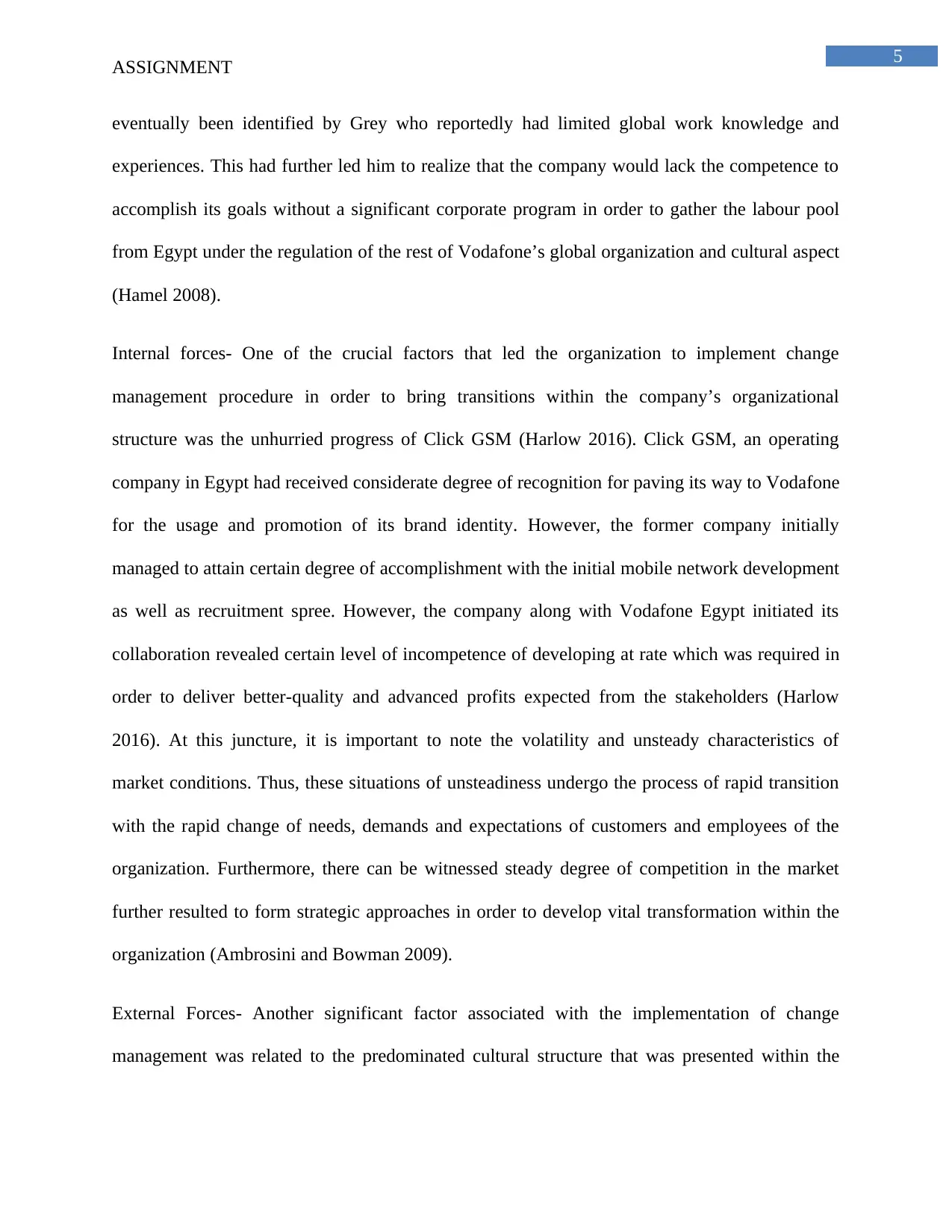
5
ASSIGNMENT
eventually been identified by Grey who reportedly had limited global work knowledge and
experiences. This had further led him to realize that the company would lack the competence to
accomplish its goals without a significant corporate program in order to gather the labour pool
from Egypt under the regulation of the rest of Vodafone’s global organization and cultural aspect
(Hamel 2008).
Internal forces- One of the crucial factors that led the organization to implement change
management procedure in order to bring transitions within the company’s organizational
structure was the unhurried progress of Click GSM (Harlow 2016). Click GSM, an operating
company in Egypt had received considerate degree of recognition for paving its way to Vodafone
for the usage and promotion of its brand identity. However, the former company initially
managed to attain certain degree of accomplishment with the initial mobile network development
as well as recruitment spree. However, the company along with Vodafone Egypt initiated its
collaboration revealed certain level of incompetence of developing at rate which was required in
order to deliver better-quality and advanced profits expected from the stakeholders (Harlow
2016). At this juncture, it is important to note the volatility and unsteady characteristics of
market conditions. Thus, these situations of unsteadiness undergo the process of rapid transition
with the rapid change of needs, demands and expectations of customers and employees of the
organization. Furthermore, there can be witnessed steady degree of competition in the market
further resulted to form strategic approaches in order to develop vital transformation within the
organization (Ambrosini and Bowman 2009).
External Forces- Another significant factor associated with the implementation of change
management was related to the predominated cultural structure that was presented within the
ASSIGNMENT
eventually been identified by Grey who reportedly had limited global work knowledge and
experiences. This had further led him to realize that the company would lack the competence to
accomplish its goals without a significant corporate program in order to gather the labour pool
from Egypt under the regulation of the rest of Vodafone’s global organization and cultural aspect
(Hamel 2008).
Internal forces- One of the crucial factors that led the organization to implement change
management procedure in order to bring transitions within the company’s organizational
structure was the unhurried progress of Click GSM (Harlow 2016). Click GSM, an operating
company in Egypt had received considerate degree of recognition for paving its way to Vodafone
for the usage and promotion of its brand identity. However, the former company initially
managed to attain certain degree of accomplishment with the initial mobile network development
as well as recruitment spree. However, the company along with Vodafone Egypt initiated its
collaboration revealed certain level of incompetence of developing at rate which was required in
order to deliver better-quality and advanced profits expected from the stakeholders (Harlow
2016). At this juncture, it is important to note the volatility and unsteady characteristics of
market conditions. Thus, these situations of unsteadiness undergo the process of rapid transition
with the rapid change of needs, demands and expectations of customers and employees of the
organization. Furthermore, there can be witnessed steady degree of competition in the market
further resulted to form strategic approaches in order to develop vital transformation within the
organization (Ambrosini and Bowman 2009).
External Forces- Another significant factor associated with the implementation of change
management was related to the predominated cultural structure that was presented within the
⊘ This is a preview!⊘
Do you want full access?
Subscribe today to unlock all pages.

Trusted by 1+ million students worldwide

6
ASSIGNMENT
company that developed certain rate of complexities and risks within the developmental progress
of the company (Vega-Jurado et al. 2008).
Issues rising to the success of change management in Vodafone Egypt
In order to mitigate the critical complexities and challenges experienced by Vodafone
Egypt on its path of success, CEO Ian Grey effectively formulated strategic approaches in order
to incorporate the level of allegiance and vigour of the local employee base within the structural
system of Vodafone devoid of certain cultural inconsiderateness. Grey initiated this strategic
approach in order to effectively comprehend to the organization’s current employee base and
further had stated that with the employment of new recruits the CEO of the business enterprise
would attain effective authorized induction, supervision as well as precise rules and directives for
management. As per his opinion, the buy-in or authoritative policies might pose critical
challenges and risks to the process of implementation of change management in Vodafone Egypt
and can further create hindrances to establish the organization to supreme Vodafone corporate
standards. It is important to note buy-in factor can reveal significant rate of potentialities to
hinder the success change whereby often CEO or the one possessing leadership skills and
abilities are held liable for the effort given for implementing transition management. It must
further be noted the way accountability and critical responsibility factors have been associated
with the actions executed within the organization (Capron and Mitchell 2009). Several aspects of
leadership involvement, communication, resource commitment, distribution of vision at initial
phase or at frequent times tend to signify the level of commitment of leader associated to
organizational transition. Thus, the CEO of Vodafone Egypt had drawn his severe concern
towards the buy-in factor in the process of success change procedures. Thus it has been stated
ASSIGNMENT
company that developed certain rate of complexities and risks within the developmental progress
of the company (Vega-Jurado et al. 2008).
Issues rising to the success of change management in Vodafone Egypt
In order to mitigate the critical complexities and challenges experienced by Vodafone
Egypt on its path of success, CEO Ian Grey effectively formulated strategic approaches in order
to incorporate the level of allegiance and vigour of the local employee base within the structural
system of Vodafone devoid of certain cultural inconsiderateness. Grey initiated this strategic
approach in order to effectively comprehend to the organization’s current employee base and
further had stated that with the employment of new recruits the CEO of the business enterprise
would attain effective authorized induction, supervision as well as precise rules and directives for
management. As per his opinion, the buy-in or authoritative policies might pose critical
challenges and risks to the process of implementation of change management in Vodafone Egypt
and can further create hindrances to establish the organization to supreme Vodafone corporate
standards. It is important to note buy-in factor can reveal significant rate of potentialities to
hinder the success change whereby often CEO or the one possessing leadership skills and
abilities are held liable for the effort given for implementing transition management. It must
further be noted the way accountability and critical responsibility factors have been associated
with the actions executed within the organization (Capron and Mitchell 2009). Several aspects of
leadership involvement, communication, resource commitment, distribution of vision at initial
phase or at frequent times tend to signify the level of commitment of leader associated to
organizational transition. Thus, the CEO of Vodafone Egypt had drawn his severe concern
towards the buy-in factor in the process of success change procedures. Thus it has been stated
Paraphrase This Document
Need a fresh take? Get an instant paraphrase of this document with our AI Paraphraser

7
ASSIGNMENT
that rate of leadership responsibility and liability has been considered as a critical factor in order
to deal with negotiation situations for change management (Keupp and Gassmann 2009).
Types of Change implemented by Ian Grey in Vodafone Egypt
Change in cultural management has been identified as one of the significant changes
implemented in Vodafone Egypt by its CEO Ian Grey. Furthermore, the operating strategically
developed approaches of the organization had been executed at the company, with the effective
identification and recognition of tasks and plans which have been developed for the assigned
projects. Furthermore, Grey aimed to formulate critical processes which had further been
employed in order to develop consistently high standards of action by and to the stakeholder
base. Thus in order to implement an effective form of transition in Vodafone Egypt, Ian Grey
must implement the Kotter’s 8 step model of change as it will aid the CEO to create the
appropriate organizational environment for the expected transition (Kotter 2012).
(Kotter 2012)
ASSIGNMENT
that rate of leadership responsibility and liability has been considered as a critical factor in order
to deal with negotiation situations for change management (Keupp and Gassmann 2009).
Types of Change implemented by Ian Grey in Vodafone Egypt
Change in cultural management has been identified as one of the significant changes
implemented in Vodafone Egypt by its CEO Ian Grey. Furthermore, the operating strategically
developed approaches of the organization had been executed at the company, with the effective
identification and recognition of tasks and plans which have been developed for the assigned
projects. Furthermore, Grey aimed to formulate critical processes which had further been
employed in order to develop consistently high standards of action by and to the stakeholder
base. Thus in order to implement an effective form of transition in Vodafone Egypt, Ian Grey
must implement the Kotter’s 8 step model of change as it will aid the CEO to create the
appropriate organizational environment for the expected transition (Kotter 2012).
(Kotter 2012)
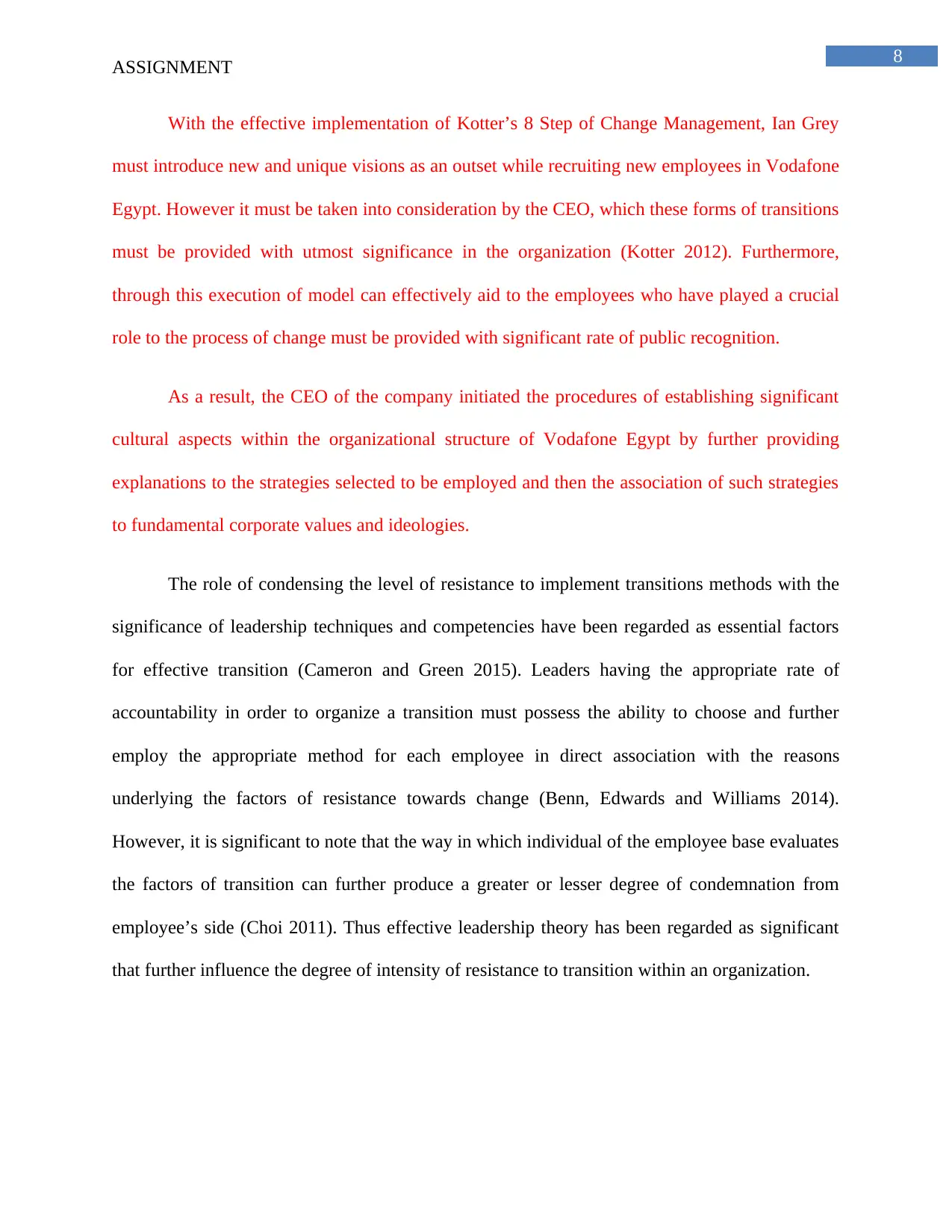
8
ASSIGNMENT
With the effective implementation of Kotter’s 8 Step of Change Management, Ian Grey
must introduce new and unique visions as an outset while recruiting new employees in Vodafone
Egypt. However it must be taken into consideration by the CEO, which these forms of transitions
must be provided with utmost significance in the organization (Kotter 2012). Furthermore,
through this execution of model can effectively aid to the employees who have played a crucial
role to the process of change must be provided with significant rate of public recognition.
As a result, the CEO of the company initiated the procedures of establishing significant
cultural aspects within the organizational structure of Vodafone Egypt by further providing
explanations to the strategies selected to be employed and then the association of such strategies
to fundamental corporate values and ideologies.
The role of condensing the level of resistance to implement transitions methods with the
significance of leadership techniques and competencies have been regarded as essential factors
for effective transition (Cameron and Green 2015). Leaders having the appropriate rate of
accountability in order to organize a transition must possess the ability to choose and further
employ the appropriate method for each employee in direct association with the reasons
underlying the factors of resistance towards change (Benn, Edwards and Williams 2014).
However, it is significant to note that the way in which individual of the employee base evaluates
the factors of transition can further produce a greater or lesser degree of condemnation from
employee’s side (Choi 2011). Thus effective leadership theory has been regarded as significant
that further influence the degree of intensity of resistance to transition within an organization.
ASSIGNMENT
With the effective implementation of Kotter’s 8 Step of Change Management, Ian Grey
must introduce new and unique visions as an outset while recruiting new employees in Vodafone
Egypt. However it must be taken into consideration by the CEO, which these forms of transitions
must be provided with utmost significance in the organization (Kotter 2012). Furthermore,
through this execution of model can effectively aid to the employees who have played a crucial
role to the process of change must be provided with significant rate of public recognition.
As a result, the CEO of the company initiated the procedures of establishing significant
cultural aspects within the organizational structure of Vodafone Egypt by further providing
explanations to the strategies selected to be employed and then the association of such strategies
to fundamental corporate values and ideologies.
The role of condensing the level of resistance to implement transitions methods with the
significance of leadership techniques and competencies have been regarded as essential factors
for effective transition (Cameron and Green 2015). Leaders having the appropriate rate of
accountability in order to organize a transition must possess the ability to choose and further
employ the appropriate method for each employee in direct association with the reasons
underlying the factors of resistance towards change (Benn, Edwards and Williams 2014).
However, it is significant to note that the way in which individual of the employee base evaluates
the factors of transition can further produce a greater or lesser degree of condemnation from
employee’s side (Choi 2011). Thus effective leadership theory has been regarded as significant
that further influence the degree of intensity of resistance to transition within an organization.
⊘ This is a preview!⊘
Do you want full access?
Subscribe today to unlock all pages.

Trusted by 1+ million students worldwide
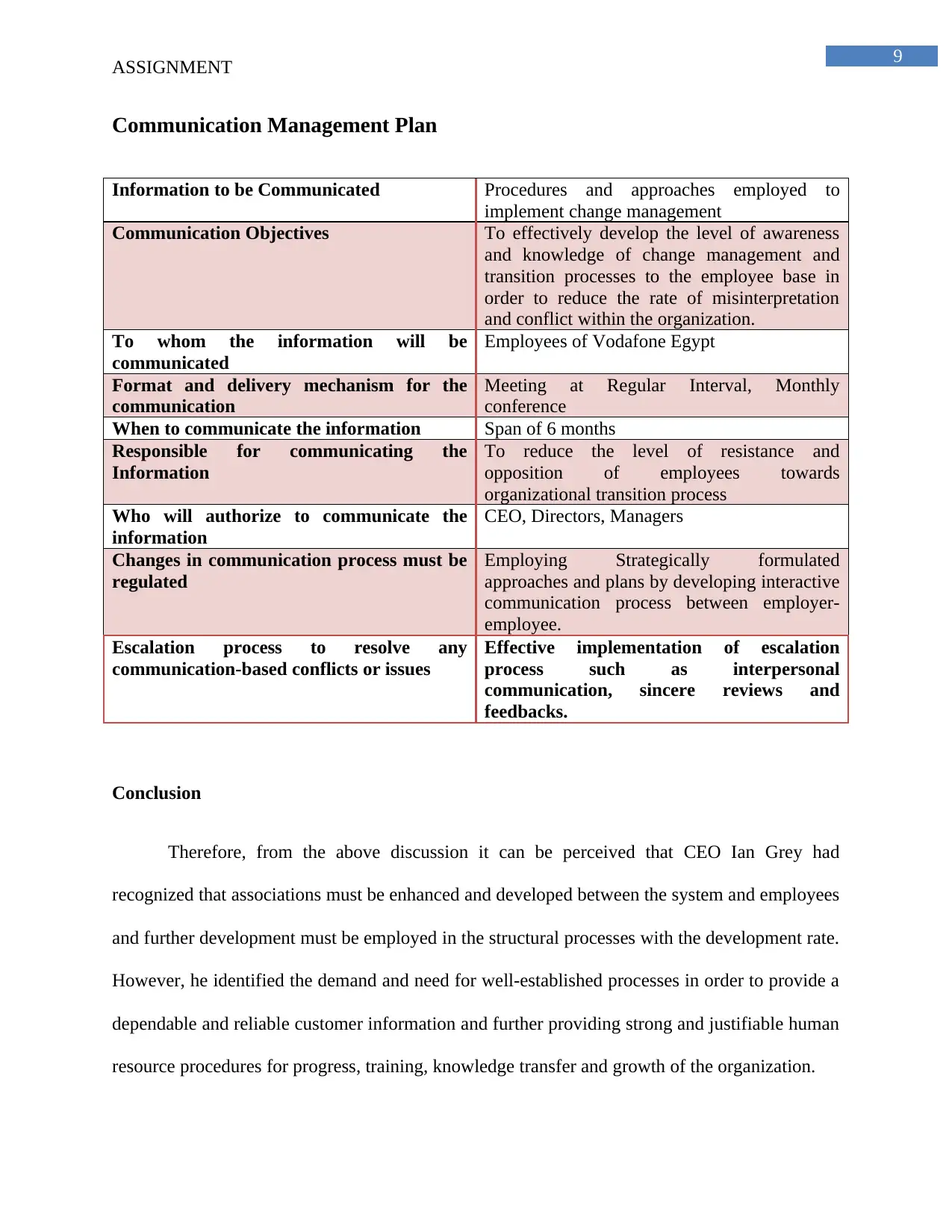
9
ASSIGNMENT
Communication Management Plan
Information to be Communicated Procedures and approaches employed to
implement change management
Communication Objectives To effectively develop the level of awareness
and knowledge of change management and
transition processes to the employee base in
order to reduce the rate of misinterpretation
and conflict within the organization.
To whom the information will be
communicated
Employees of Vodafone Egypt
Format and delivery mechanism for the
communication
Meeting at Regular Interval, Monthly
conference
When to communicate the information Span of 6 months
Responsible for communicating the
Information
To reduce the level of resistance and
opposition of employees towards
organizational transition process
Who will authorize to communicate the
information
CEO, Directors, Managers
Changes in communication process must be
regulated
Employing Strategically formulated
approaches and plans by developing interactive
communication process between employer-
employee.
Escalation process to resolve any
communication-based conflicts or issues
Effective implementation of escalation
process such as interpersonal
communication, sincere reviews and
feedbacks.
Conclusion
Therefore, from the above discussion it can be perceived that CEO Ian Grey had
recognized that associations must be enhanced and developed between the system and employees
and further development must be employed in the structural processes with the development rate.
However, he identified the demand and need for well-established processes in order to provide a
dependable and reliable customer information and further providing strong and justifiable human
resource procedures for progress, training, knowledge transfer and growth of the organization.
ASSIGNMENT
Communication Management Plan
Information to be Communicated Procedures and approaches employed to
implement change management
Communication Objectives To effectively develop the level of awareness
and knowledge of change management and
transition processes to the employee base in
order to reduce the rate of misinterpretation
and conflict within the organization.
To whom the information will be
communicated
Employees of Vodafone Egypt
Format and delivery mechanism for the
communication
Meeting at Regular Interval, Monthly
conference
When to communicate the information Span of 6 months
Responsible for communicating the
Information
To reduce the level of resistance and
opposition of employees towards
organizational transition process
Who will authorize to communicate the
information
CEO, Directors, Managers
Changes in communication process must be
regulated
Employing Strategically formulated
approaches and plans by developing interactive
communication process between employer-
employee.
Escalation process to resolve any
communication-based conflicts or issues
Effective implementation of escalation
process such as interpersonal
communication, sincere reviews and
feedbacks.
Conclusion
Therefore, from the above discussion it can be perceived that CEO Ian Grey had
recognized that associations must be enhanced and developed between the system and employees
and further development must be employed in the structural processes with the development rate.
However, he identified the demand and need for well-established processes in order to provide a
dependable and reliable customer information and further providing strong and justifiable human
resource procedures for progress, training, knowledge transfer and growth of the organization.
Paraphrase This Document
Need a fresh take? Get an instant paraphrase of this document with our AI Paraphraser

10
ASSIGNMENT
References
Ambrosini, V. and Bowman, C., 2009. What are dynamic capabilities and are they a useful
construct in strategic management?. International journal of management reviews, 11(1), pp.29-
49.
Anderson, D. and Anderson, L.A., 2010. Beyond change management: How to achieve
breakthrough results through conscious change leadership (Vol. 36). John Wiley & Sons.
Benn, S., Edwards, M. and Williams, T., 2014. Organizational change for corporate
sustainability. Routledge.
Cameron, E. and Green, M., 2015. Making sense of change management: A complete guide to
the models, tools and techniques of organizational change. Kogan Page Publishers.
Capron, L. and Mitchell, W., 2009. Selection capability: How capability gaps and internal social
frictions affect internal and external strategic renewal. Organization Science, 20(2), pp.294-312.
Choi, M., 2011. Employees' attitudes toward organizational change: A literature review. Human
Resource Management, 50(4), pp.479-500.
Simpson, P., 2012. Complexity and change management: analyzing church leaders'
narratives. Journal of Organizational Change Management, 25(2), pp.283-296.
Hamel, G., 2008. The future of management. Human Resource Management International
Digest, 16(6).
ASSIGNMENT
References
Ambrosini, V. and Bowman, C., 2009. What are dynamic capabilities and are they a useful
construct in strategic management?. International journal of management reviews, 11(1), pp.29-
49.
Anderson, D. and Anderson, L.A., 2010. Beyond change management: How to achieve
breakthrough results through conscious change leadership (Vol. 36). John Wiley & Sons.
Benn, S., Edwards, M. and Williams, T., 2014. Organizational change for corporate
sustainability. Routledge.
Cameron, E. and Green, M., 2015. Making sense of change management: A complete guide to
the models, tools and techniques of organizational change. Kogan Page Publishers.
Capron, L. and Mitchell, W., 2009. Selection capability: How capability gaps and internal social
frictions affect internal and external strategic renewal. Organization Science, 20(2), pp.294-312.
Choi, M., 2011. Employees' attitudes toward organizational change: A literature review. Human
Resource Management, 50(4), pp.479-500.
Simpson, P., 2012. Complexity and change management: analyzing church leaders'
narratives. Journal of Organizational Change Management, 25(2), pp.283-296.
Hamel, G., 2008. The future of management. Human Resource Management International
Digest, 16(6).

11
ASSIGNMENT
Harlow, H.D., 2016. Vodafone Egypt (B), managing corporate cultural change and
organizational performance. Emerald Emerging Markets Case Studies, 6(4), pp.1-17.
Hayes, J., 2018. The theory and practice of change management.
Keupp, M.M. and Gassmann, O., 2009. Determinants and archetype users of open
innovation. R&d Management, 39(4), pp.331-341.
Kotter, J.P., 2012. Leading change. Harvard business press.
Vega-Jurado, J., Gutiérrez-Gracia, A., Fernández-de-Lucio, I. and Manjarrés-Henríquez, L.,
2008. The effect of external and internal factors on firms’ product innovation. Research
policy, 37(4), pp.616-632.
Wheelen, T.L. and Hunger, J.D., 2011. Concepts in strategic management and business policy.
Pearson Education India.
Zink, K.J., Steimle, U. and Schröder, D., 2008. Comprehensive change management concepts:
Development of a participatory approach. Applied ergonomics, 39(4), pp.527-538.
ASSIGNMENT
Harlow, H.D., 2016. Vodafone Egypt (B), managing corporate cultural change and
organizational performance. Emerald Emerging Markets Case Studies, 6(4), pp.1-17.
Hayes, J., 2018. The theory and practice of change management.
Keupp, M.M. and Gassmann, O., 2009. Determinants and archetype users of open
innovation. R&d Management, 39(4), pp.331-341.
Kotter, J.P., 2012. Leading change. Harvard business press.
Vega-Jurado, J., Gutiérrez-Gracia, A., Fernández-de-Lucio, I. and Manjarrés-Henríquez, L.,
2008. The effect of external and internal factors on firms’ product innovation. Research
policy, 37(4), pp.616-632.
Wheelen, T.L. and Hunger, J.D., 2011. Concepts in strategic management and business policy.
Pearson Education India.
Zink, K.J., Steimle, U. and Schröder, D., 2008. Comprehensive change management concepts:
Development of a participatory approach. Applied ergonomics, 39(4), pp.527-538.
⊘ This is a preview!⊘
Do you want full access?
Subscribe today to unlock all pages.

Trusted by 1+ million students worldwide
1 out of 19
Related Documents
Your All-in-One AI-Powered Toolkit for Academic Success.
+13062052269
info@desklib.com
Available 24*7 on WhatsApp / Email
![[object Object]](/_next/static/media/star-bottom.7253800d.svg)
Unlock your academic potential
Copyright © 2020–2025 A2Z Services. All Rights Reserved. Developed and managed by ZUCOL.




